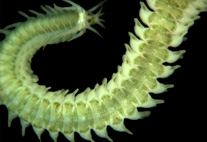Abstract
The barcoding approach was applied to analyze 16 Australian morphospecies of the order Phasmida, with the aim to test if it could be suitable as a tool for phasmid species identification and if its discrimination power would allow uncovering of cryptic diversity. Both goals were reached. Eighty-two specimens representing twelve morphospecies (Sipyloidea sp. A, Candovia annulata, Candovia sp. A, Candovia sp. B, Candovia sp. C, Denhama austrocarinata, Xeroderus kirbii, Parapodacanthus hasenpuschorum, Tropidoderus childrenii, Cigarrophasma tessellatum, Acrophylla wuelfingi, Eurycantha calcarata) were correctly recovered as clades through the molecular approach, their sequences forming monophyletic and well-supported clusters. In four instances, Neighbor-Joining tree and barcoding gap analyses supported either a specific (Austrocarausius mercurius, Anchiale briareus) or a subspecific (Anchiale austrotessulata, Extatosoma tiaratum) level of divergence within the analyzed morphospecies. The lack of an appropriate database of homologous coxI sequences prevented more detailed identification of undescribed taxa.

